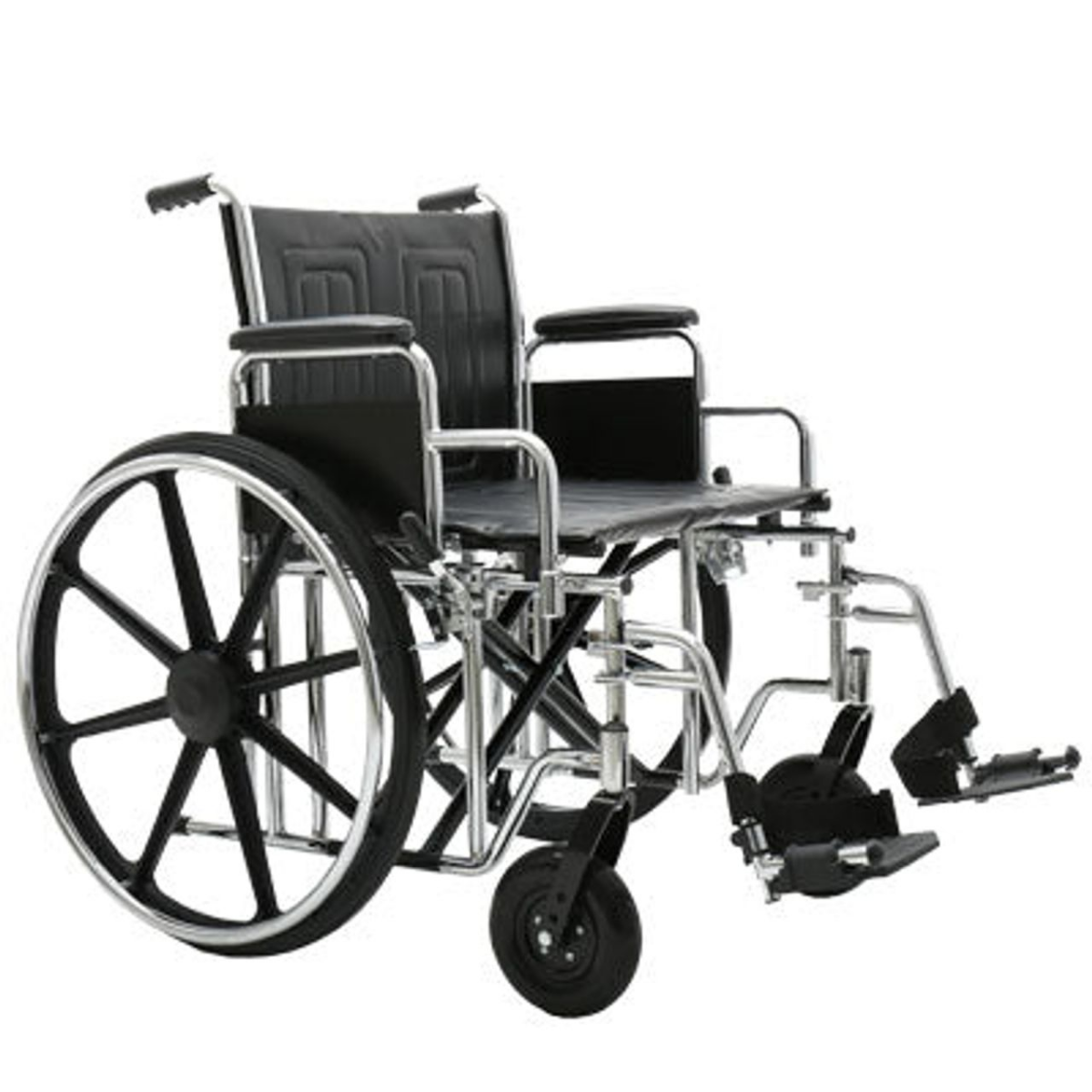-
 Free Delivery
Free Delivery
Couldn't load pickup availability
- Description
- Instructions
- Reviews
This robust yet economical self-propelling wheelchair is ideal for larger individuals, supporting up to 250 kilograms. It folds easily for storage or transportation, and the removable armrests and swing-away leg rests assist with getting in and out of the chair - an excellent benefit for the user and caregivers.
This wheelchair is available in different seat sizes.
Features
- Chrome polish finish steel frame
- Steel black shirt-guards
- Detachable full armrest
- Sponge arm pads for extra comfort
- Swing-away footrest
- Aluminium footplate
- Chrome steel handle rim
- Folds for easy storage and transport
- Padded PVC upholstery
- 24" mag wheels with PU tyres
- 8" x 2" front castors with PU tyres
- 1-year warranty
- See the brochure
Specifications
Please note - these 3 available wheelchair models are wider than many standard NZ doors, so please measure before purchase. See below for the overall width of each model.
| Overall |
AMLWCSPB20 AMLWCSPB22 AMLWCSPB24 |
| Seat Depths | 45cm (18") |
| Overall Length | 107cm (42") |
| Overall Height | 92cm (36") |
| Folding Frame | Yes |
| Tilt in space | No |
| Recline | No |
| Minimum Seat to seat-to-floor height | 45cm (19.5") |
| Standard legrest style | Swingaway |
| User Weight Limit | 250 kg |
| Total Unit Weight | 30 kg |
| Seating | Padded PVC upholstery |
| Armrests | Removable full length |
| Brakes | Push to lock |
| Rear Wheel Size | 24" PU mag wheels |
| Castor Size | 8" x 2" PU |
How do I fold my manual wheelchair?
One of the easiest ways to do this is to lift the upholstery in the centre of the wheelchair seat. To unfold the wheelchair, tilt slightly to one side and press on one or both seat rails (left and right).
And remember to keep your fingers and hands clear of any moving parts! If you don't, you'll only do it once. Ouch!
How do I know what size wheelchair is suitable?
Just like items of clothing such as shoes, the wheelchair must fit the person using it well enough to ensure they are comfortable and that it's not likely to press on any part of their body, as this has the potential to create pressure areas.
To ensure the right fit, you need to be able to tell us the following:
- The measurement from your bottom to your shoulder (taken when you are sitting).
- The measurement is from the back of your bottom to the back of your knee.
- The measurement from behind the knee to your heel (when sitting).
- The widest measurement across your hips or upper legs when seated.
- Telling us your weight also helps, as different wheelchairs have different user weight limits.
If you can't get all these measurements, there are a couple of simple things that you can do once you are in a wheelchair to make sure that it fits you okay:
- Is there enough room to slide your hand between the armrest and thigh? If this is not possible, you need to try a larger size.
- Can you put two fingers behind your knee before hitting the seat upholstery? If not, you must get a wheelchair with a longer seat depth.
The good news is that if you are working with a therapist to help select a suitable wheelchair, they will take all the necessary measurements during your assessment, so you don't need to worry about this!
Why do you need to have leg rests that swing away?
If the leg rests swing away, the wheelchair user can get closer to the object they are being transferred onto, like a bed or a chair. The swing-away leg rests also make it easier if a hoist or piece of equipment is used to help transfer the wheelchair user and get them closer to the wheelchair, making the transfer more manageable and safer.
Once I have my wheelchair, what maintenance is it going to need?
Most wheelchairs have a basic instruction manual outlining any specific regular maintenance required for that model.
In general, it is a good idea to check the following monthly:
- If you have pneumatic tyres on your wheelchair, check that the air pressure in the tyres is correct – the correct pressure is indicated on the side of the tyre.
- Check that the axle housing is dirt, hair, and mud-free. Clean any dirt or hair gathered around the axles – the wheels must spin freely.
- Ensure the castors run smoothly – ensure no hair, fluff or grit in the castors.
- Check the brakes hold the tyre firmly in place and are easy to put on and off.
- Check the nuts and bolts are all tight and secure.
Other words of advice when choosing a wheelchair.
Try as many as possible – visit one of our Resellers who will hold several different models in stock so you can compare them there. Their staff are trained to assist people in finding the right size wheelchair for them within their price range.
Customer Reviews


